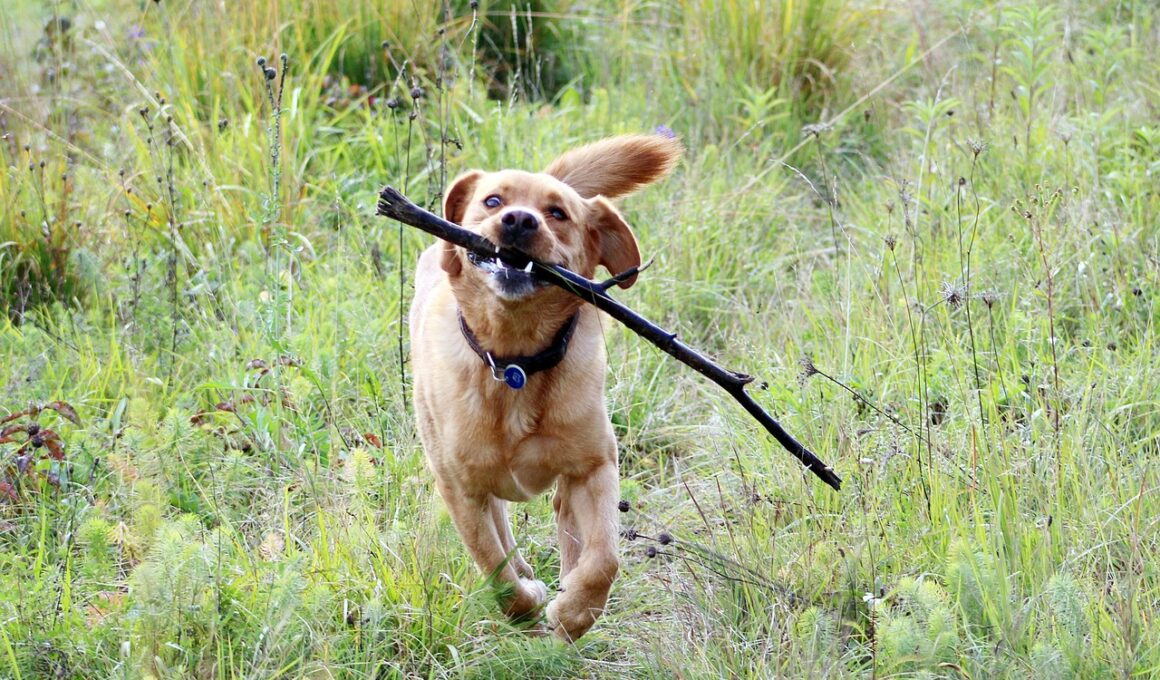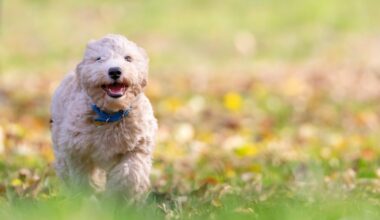Using Target Sticks to Teach New Tricks to Your Dog
Target sticks are an excellent tool for dog training that can greatly improve the way you teach your dog. These sticks can help guide your dog to do various tricks while enhancing their focus and attention. Using a target stick encourages your dog to engage in activities such as sit, stay, or even complex tricks like dancing or spinning. Starting with a simple target stick allows you to modify the distance and intensity of the task, depending on your dog’s learning pace. Utilizing this technique creates a positive experience for both you and your dog. It’s crucial to keep the sessions short and enjoyable to maintain your dog’s interest. Additionally, rewarding your dog with treats and praise reinforces the desired behavior, making learning a fun experience. Target sticks are versatile in their use; they can also be employed for agility training or behavior modification. By incorporating a target stick into your training routine, you can enhance your communication with your dog, resulting in a well-behaved pet that enjoys learning new tricks. Consider investing in a quality target stick for effective dog training sessions.
When it comes to introducing the target stick, consistency is key. Begin by letting your dog become familiar with the stick; this initial phase helps establish a positive relationship with the new equipment. Hold the stick in front of your dog and encourage them to touch it with their nose or paw. As they get used to this, reward them with a treat to ensure they understand that interacting with the target stick is a good thing. Gradually increase the distance from which your dog needs to touch the stick, providing clear commands and rewards for successful attempts. Always observe your dog’s comfort level throughout the process. It’s essential to remain patient and encouraging as your dog learns to trust and engage with the target stick. The gradual training method allows them to associate the stick with fun and praise, which could positively impact their overall learning experience. Remember, dogs thrive on positive reinforcement, so use treats and enthusiastic praise liberally. Once your dog starts understanding the command related to the target stick, you can begin incorporating more complex tricks into your training sessions. This way, your dog will stay mentally stimulated and engaged.
Creating a Target Stick Training Plan
A well-structured training plan with the target stick helps to achieve the best results in dog training. Start this plan by determining which tricks you want to teach and what skills will be required. Next, break down these tricks into smaller, manageable tasks that can be taught progressively. For example, if you want to teach your dog to roll over, first, teach them how to lie down using the target stick as guidance. Once they have mastered the lying down position, use the target stick to guide them into the rolling action. Throughout your training sessions, always stay focused on your dog’s learning pace and confidence levels, adjusting your plan as needed. Informal practice sessions can be highly beneficial, just ensure they last for about 5-10 minutes and aren’t too overwhelming. Repetition is essential for dog learning, so practice frequently but keep the sessions enjoyable. Once your dog shows familiarity and comfort with the target stick, slowly introduce distractions to ensure they remain focused. This structured approach will help in solidifying the connection between the target and the behavior you want to achieve.
Incorporating a variety of training techniques alongside the target stick can create a richer learning experience for your dog. For instance, blending clicker training and verbal cues can significantly enhance your dog’s performance. When using the target stick, you can simultaneously click when your dog successfully touches the stick or performs the desired task. This dual reinforcement creates a clear communication channel between you and your dog. Additionally, verbal cues like ‘touch’ or ‘follow’ can be used consistently so your dog can associate the target stick with these commands. Every time your dog successfully responds, ensure you offer a treat promptly to reinforce valid actions. Mixing different techniques helps to avoid monotony and keeps your dog more engaged. You might consider mixing in some playtime as well; after a successful training session, allowing some freedom and play can uplift your dog’s mood. Furthermore, practicing outside of structured sessions can add another layer of fun for your dog. Ultimately, providing a varied and engaging environment will deepen the trust and respect between you and your canine companion.
Adapting Target Stick Training for Different Breeds
When training with target sticks, it’s crucial to adapt your approach based on your dog’s size, breed, and temperament. Larger breeds may require different techniques than smaller ones due to their physical capabilities and eagerness to learn. For instance, a Great Dane might benefit from broader movements compared to a Yorkshire Terrier, who could engage more effectively with quicker, smaller motions. Understanding breed tendencies is also essential; some breeds are more stubborn while others may pick up tricks rapidly. Patience is vital, especially if your dog appears hesitant or disinterested in the target stick. Break down the tasks even further and give plenty of encouragement. Adjusting your expectations based on your dog’s instincts and abilities can enhance their learning. Using shorter stick lengths for smaller breeds and longer ones for larger breeds can also help in making training sessions more efficient. Keep in mind that each dog is unique, and this requires flexibility in your training sessions. You may even observe that certain techniques work better for some breeds than others, so don’t hesitate to experiment to discover what suits your dog best.
Maintaining your dog’s well-being throughout the training process is paramount. Overtraining or repetitive sessions can lead to frustration for both you and your dog. It’s essential to monitor your dog’s reactions to ensure they are engaged and not overwhelmed. If you notice signs of weariness, take a break and try again later—this keeps your training fun and exciting. Always remember to include ample downtime and plenty of praise, reinforcing a positive experience. This nurturing approach applies equally well when working with puppies or elderly dogs, who may have different energy levels and learning capacities. It’s wise to adapt your methods as needed, offering breaks and alternate activities to maintain their enthusiasm. Physical exercise is also crucial alongside mental stimulation, so incorporate walks or playtime as key components of your routine. Encouraging interactions with other dogs or people during training can foster social skills, making the overall training session beneficial. By respecting your dog’s limits and capacities throughout the journey, you will foster a strong bond built on trust and love, making every training experience enriching and enjoyable.
Conclusion: The Enduring Benefits of Using Target Sticks
The use of target sticks for dog training is a valuable tool that can yield significant benefits. Not only do they assist in teaching various tricks and skills, but they also promote communication between you and your dog. A well-executed training session enhances your dog’s physical and mental abilities, ensuring they remain sharp and engaged. Target sticks can also boost your dog’s confidence, as they consistently receive praise and rewards for their efforts. This method strengthens your canine companion’s trust in you as a positive figure in their life. Moreover, these sessions allow both you and your dog to spend quality time together, creating lasting memories. The socialization aspect is invaluable, as spending time training with your dog nurtures a sense of teamwork. Additionally, many owners have found success using target sticks in behavioral modifications, proving their versatility. As you explore various tricks and skills to teach your dog, consider the potential of target sticks. Overall, investing time and effort into using a target stick will open up new opportunities to learn and grow together with your furry friend.
Overall, target sticks represent an innovative approach to dog training. They provide structure while allowing creativity to flourish in your sessions. Through consistency, patience, and positive reinforcement, you can achieve remarkable results with your furry companion. Keep your training light-hearted and fun, catering to your dog’s individual personality. By investing in a quality target stick and incorporating it into your training arsenal, you will find a wealth of opportunities ahead. Your dog’s eagerness to learn will surprise you, and both of you will enjoy the experience along the way. If you’re keen on effective dog training that employs modern techniques, definitely explore target sticks. This method not only enhances communication but deepens the bond between you and your dog. The rewards are countless, and your dog will appreciate every shared moment spent training. Future training sessions have the potential to be even more exciting as your dog learns progressively more complex tricks. Start today and watch the magic unfold as you nurture your dog in learning. The world of tricks and teamwork opens a new realm of possibilities for your dog and you. Embark together on this remarkable journey!


